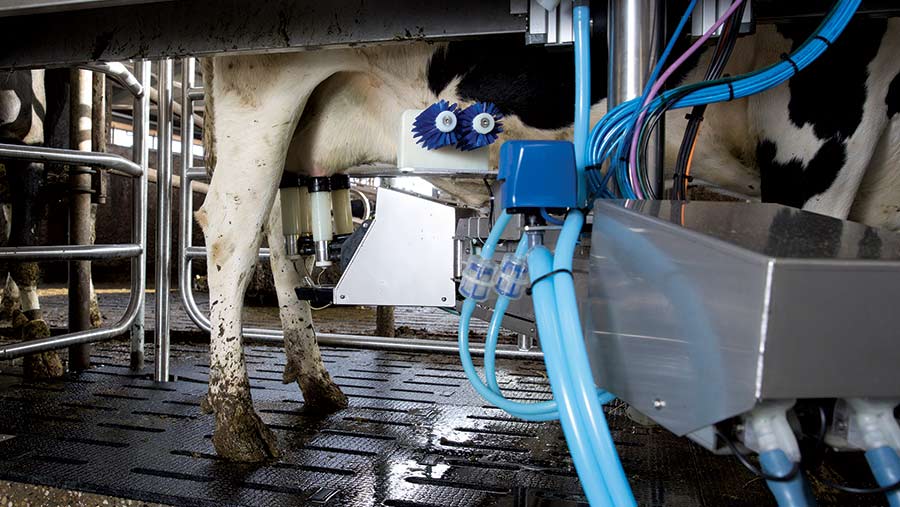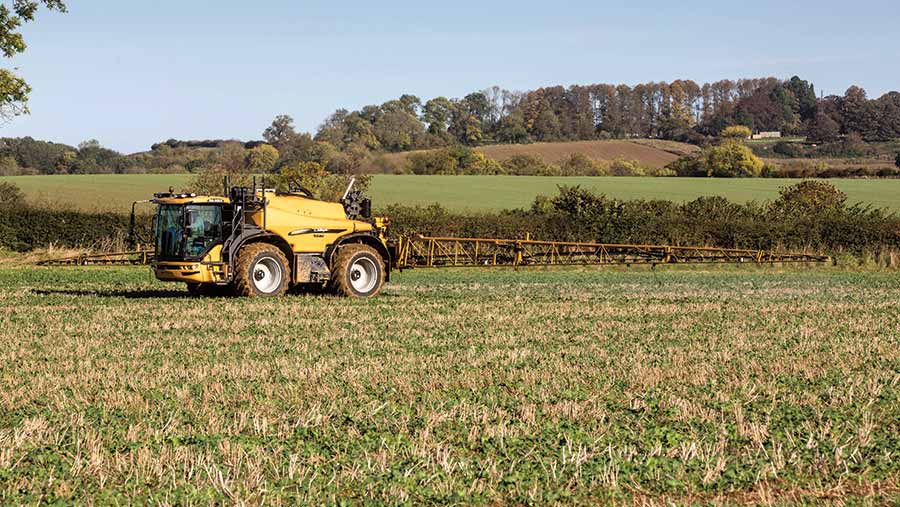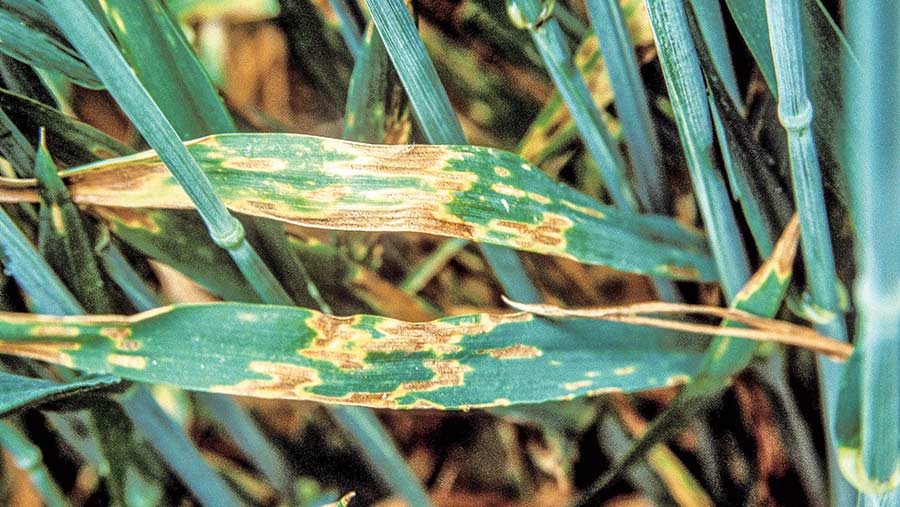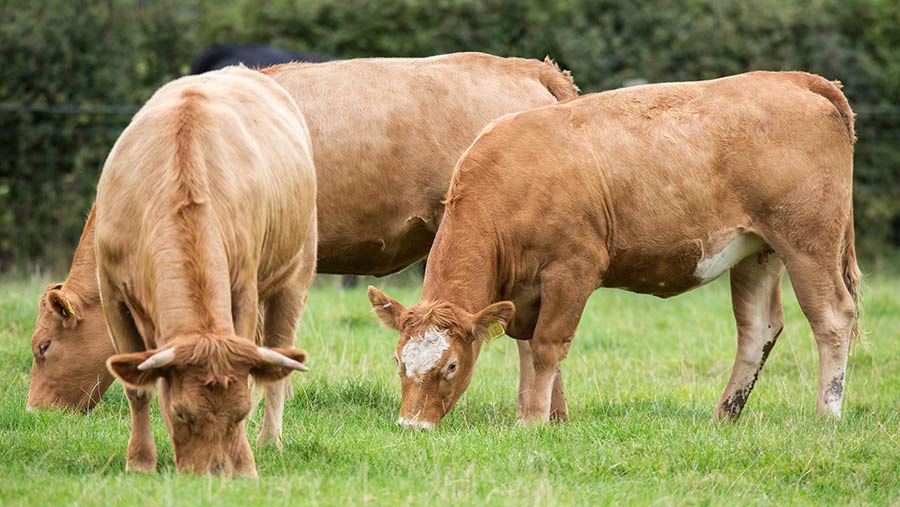Can Agri-Tech deliver new ‘golden age’ for farmers?
Increasing agricultural productivity by improving UK farming practices is among the key aims of the government’s Agri-Tech strategy – a £90m investment with four Agri-Tech centres at its heart.
The technology these centres produce aims to revolutionise farming with tools to raise profits and improve Britain’s farm productivity, which lags well behind that of its global competitors.
For example, the contribution of UK farming to the economy would have been £4.3bn higher by 2013 had the rate of growth kept pace with the United States since 2000, according to AHDB figures.
See also: Agri-Tech Q&A – How science and technology can help farming
The four Agri-Tech centres
Agricultural Engineering Precision Innovation (Agri-EPI)
Agri-EPI harnesses precision agriculture to develop technologies that increase productivity and sustainability in the agri-food sector.
View case study
Agrimetrics
Agrimetrics uses agriculture data science and modelling to build a more productive, sustainable and efficient food system.
View case study
Crop Health and Protection (Chap)
Chap aims to revolutionise how farmers manage crop threats including pests and disease.
View case study
Centre for Innovation Excellence in Livestock (Ciel)
Ciel aims to create new livestock technology and products to boost the profitability and productivity of livestock farming.
View case study
“We have got to recover some of that and get our productivity back on pace again,” says Dave Ross, chief executive of the Agri-EPI centre.
The UK is getting better but still lags behind competitor countries including the Netherlands, Germany and the US, he adds.
A step-change in crop and livestock productivity is needed to help bridge this gap, Mr Ross believes. The uptake of precision and data technologies can reduce costs of food production and minimise impacts on the environment while raising farm profits, he says.
Different sectors require different solutions, adds Fraser Black, of the Crop Health and Protection Agri-Tech centre.
But as a starting point, all farmers should look for ways to optimise inputs and outputs while reducing the amount of waste their business generates.
Who benefits?
At recent field demonstrations at Newcastle University’s Cockle Park Farm, more than 200 entrepreneurs, scientists and engineers saw robots and drones such as the Agri-Rover, an autonomous vehicle that tests soil as it moves over the ground.
Close by, experts from Scotland’s Rural College showed how a medical CT scanner could identify the best sheep for breeding.
Farmer faces at the event, which was organised by government agency Innovate UK, were few and far between. But the two days were primarily a networking opportunity for agri-tech specialists, rather than a showcase for producers.
That said, some of the farmers present voiced frustration that the event was perhaps more impressive than practical. Critics included Tom Wornham, who travelled 260 miles from Buntingford in Hertfordshire to see how the latest agri-technology might benefit his poultry business.
“It’s wonderful that there is an enthusiasm for investment in agriculture – but it’s being driven by people who think there are improvements to be made in agriculture, rather than by farmers themselves.”
Other producers have voiced similar concerns. They fear some farmers could be left behind as bigger players – processors, retailers and multinationals – benefit from increasingly technological ways of producing food.
Helen Ferrier, who leads the NFU’s work on agricultural science and research, says: “Innovators and early adopters will see benefits relatively immediately.
As is always the case, it will take much longer to get diffusion throughout the industry of any new approaches.”
Innovate UK acknowledges the criticism – but says the centres have been involved in 105 projects and have reached 35,000 UK farmers, with many more to benefit in the years ahead.
The issue, it adds, is one of communication, rather than lack of engagement.
“It is about getting the message out there,” says Innovate UK’s Ian Cox, who is leading the rollout of the £90m programme. “People want to engage with the centres when they find out what they are going to deliver.”
What about data safety?
Encouraging farmers to share data is crucial to maximise the benefits of agri-tech – and the Agri-Tech centres accept they must show data-sharing can be done safely and securely.
“Attitudes and behaviours” were cited as the biggest barrier (39%) to using data in a poll of more than 200 delegates at the Newcastle event. Other challenges included fragmentation (28%), ease of access (17%), complexity (11%) and security and trust (6%).
“You hear about data breaches every day,” says Agrimetrics chief executive David Flanders. “As far as we know – and certainly in the UK – we are the only agri-food data provider that has ISO27001 certification.”
ISO27001 is an international, externally audited standard for safe data handling. It seeks to guarantee that any data shared by farmers is used correctly. Farmers retain data ownership while reaping the benefits of sharing it anonymously – for example, by benchmarking business performance.
“It is your data and your value – the whole point of Agrimetrics is to provide insight to help you develop your business,” says Mr Flanders. “It is absolutely crucial.”
Why farmer input is crucial
Some farmers are indeed benefiting already. They include Suffolk and Gloucestershire cereal growers John Pawsey and Jake Freestone, who have helped test the CropScan 3000h – a high-tech monitor that tests and samples grain as it is harvested.
CropScan samples moisture, quality and oil levels every eight seconds – helping growers segregate or blend the crop into different batches and maximising the proportion that commands a premium. If further trials are successful, it will be rolled out more widely.
Other projects are forging ahead too. In a field at Cockle Park Farm, the team from DroneAg was demonstrating the Skippy Scout, a drone app that aims to make field-walking a thing of the past – and reduce pesticide use – by monitoring crops with an unmanned aerial vehicle.
Developed by farming brothers Jack and Hugh Wrangham, DroneAg launched a £250,000 crowdfunding campaign to develop the Skippy Scout further. Being “farmers who know drones” gives the company the insight to deliver what growers need, Jack believes.
“As a farmer’s son, I know the difficulties farmers face,” he says.
How well does Agri-Tech deliver?
There’s no doubt that the Agri-Tech centres have great potential – but some farmers stand to benefit more than others.
The centres were set up to benefit the wider agri-food sector, not just agriculture, so it is important that farmers engage with them proactively rather than wait to be approached.
Wider benefits will take time to trickle across whole supply chain – and deliver economies of scale – making it imperative that the government supports Agri-Tech centres for the longer term.
The centres themselves must focus on better engagement with growers and livestock producers. Farmers need closer involvement with projects and a greater say in how they work – and those projects need to apply across all farm types and sizes, not just the larger ones.
Closer links between scientists and farmers will help to ensure agri-tech delivers the right solutions.
Case study: Agri-Epi
Robotic milkers raise output and improve life on the farm
Fife dairy farmer Brian Wetherup has seen yields increase by 20% after teaming up with Agri-EPI to get the most from the robotic milkers that are installed at Parkend Farm, Crossgates, Cowdenbeath.
“We are a family-run farm and good labour is hard to get hold of,” says Mr Wetherup. “We decided we had to go down the technology route and came across Agri-EPI when we were deciding which robotic milkers to install.”
Working with Agri-EPI has given Mr Wetherup access to lots of new technology, including high-tech collars that monitor cow performance.
“It adds masses of value to our business by being able to reduce the calving interval and treating animals before they get sick,” he says.

Having milked cows for 50 years, Mr Wetherup’s father was initially sceptical about the robots. But he is now a big advocate, having seen yields for the 180-cow Holstein herd go from 10,400 litres to 12,500 litres on a 305-day lactation.
The robots have freed up time too. “We reckon, between the two of us, we probably have five extra man hours every day to dedicate to either improving things on the farm, such as cow welfare, or spending more time with our families, which can only be a good thing,” explains Mr Wetherup.
Parkend Farm is one of Agri-EPI’s network of 28 satellite farms. The farms – encompassing all the main agricultural enterprises – have been set up as test-beds for research and development, to aid the improvement of productivity and efficiency within the sector.
Mr Wetherup says his £400,000 investment in the robot milkers sounds huge – but was well worth it. He initially thought it would take up to 10 years to pay back. But the increase in yields means it is likely to be less than eight years. “It will be a huge bonus to the business,” he says.
With margins tight on many farms, someproducers will feel that this sort of investment is beyond them. But those who have access to finance are more likely to feel it worthwhile.
Fact file: agri-EPI
Name: The Engineering, Precision and Innovation Centre for Agriculture
Location: Penicuik, Midlothian
Initial funding: £17.7m (estimated)
Website: Agricultural Engineering Precision Innovation
Goals
– Providing world-class research and business incubation
– Encouraging robotics, sensing and imaging technology
– Facilitating partnerships between industry and academics
Achievements
– Innovation hubs at Cranfield, Harper Adams and Edinburgh
– Access to a network of 100 leading agri-food companies
– Supporting the first advanced training centre in agri-robotics
Farmers Weekly says…
The Agri-EPI centre is helping to develop some of the most exciting technology in agriculture, such as driverless farm vehicles, drones, robots and high-tech scanners that measure grain quality as crops are harvested.
Many of the projects are at the cutting edge, and are yet to be commercialised, These include research into safety features required for autonomous off-road farm vehicles to operate in on-road situations.
Some developments won’t make it to market, but others will – with big benefits. But some of the technology is so advanced it will take time before it is within reach of smaller producers.
Agri-EPI says…
More farmers are looking at what they can do to make their businesses more resilient in an increasingly uncertain world – under whatever scenario they might face in the future.
Transformative technology can help create a better and more productive agricultural system that will be – by definition – more resilient whatever circumstances prevail. It can also create exciting new jobs which attract new talent into the sector.
Dave Ross, chief executive
Case study: Agrimetrics
Shared data increases farm productivity and environment
Growers are reducing run-off from herbicides – boosting productivity while protecting the environment – by using a water stewardship decision tool, developed by agrochemical firm BASF in partnership with Agrimetrics.
The spraying decision app helps oilseed rape growers determine whether or not it is safe to apply quinmerac or metazachlor products over an eight-day period, explains BASF solutions and services manager Louis Wells.
“We want the herbicides to be in the field, where they are doing a job controlling weeds,” he says. “Secondly, from a water stewardship perspective, it can cost water stewardship companies quite a lot of money to try and remove these chemistries from the water.”

© Tim Scrivener
Using data from the Met Office, Defra and the Environment Agency, combined with field-specific information about soil type, drainage and cultivation method, the app tells growers when it is safe to spray – and when the risk of run-off is too high.
“Agrimetrics brings all those different threads of data into one place, which makes it much easier.
Rather than going to five or six different organisations and getting individual data streams from each of them, we are able to build everything together working with just one partner,” says Mr Wells.
Focused on agricultural informatics, Agrimetrics was the first Agri-Tech centre to open in October 2015. Its founding partners were the National Institute of Agricultural Botany (Niab), Reading University, Rothamsted Research and SRUC – Scotland’s Rural College.
Since then, Agrimetrics has also built partnerships with multinational companies Airbus, for aerial imagery; and Microsoft, for artificial intelligence – working across multiple agri-food sectors, rather than specialising in only the arable or livestock industries.
In terms of livestock, Agrimetrics is helping Japanese tech company Fujitsu develop technology that predicts oestrus in UK dairy cows. It monitors step-count data using an algorithm that detects behavioural changes, such as a steep increase in movement.
Fact file: Agrimetrics
Name: Data science, analytics and modelling for the agri-food chain
Location: Harpenden, Hertfordshire
Initial funding: £13m
Website: Agrimetrics
Goals
– Sourcing data to unlock additional value for agri-food
– Linking complex and often fragmented information
– Providing services to help others build data capabilities
Achievements
– Biggest UK investment in connecting agri-food data
– Forged partnerships with Airbus, Microsoft and Fujitsu
– ISO 27001 accredited for data governance and security
Farmers Weekly says…
Agrimetrics has a difficult job on its hands. But the potential rewards for farmers and the wider food chain far outweigh the challenges it faces – so long as it gets it right.
Agriculture generates lots of data – from crop and livestock performance information to details about weather, soil types and satellite imagery. In the past, this data was hard to manage because it was in different formats and in different places.
Agrimetrics can link data while keeping it in its original format – making it easier to create cost-effective tools and apps that benefit farmers. But producers need to know data is looked after securely before handing it over.
Agrimetrics says…
Data is already revolutionising the agri-food supply chain. However, the benefits will remain piecemeal until the sector is able to bring together the disparate groups into a cohesive whole.
We don’t want to control data; we don’t want to own data. We want to make data available to all – and add value to that data and expertise, and help you to get the most out of it.
David Flanders, chief executive
Case study: Chap
CropMonitor helps manage pests and diseases at hyper-local level
Growers will soon be able to benefit from a new national decision support service to better control crop diseases and pests.
CropMonitor Pro will be available this autumn. It is a highly detailed system based on the CropMonitor information service, first launched by Fera Science in 2003.
But it promises to be much more powerful, delivering risk forecasting nationally at a local field-scale level as a subscription service from this autumn.

© Blackthorn Arable
Real-time information will help growers make more effective decisions about which treatments to apply and when, says the Chap centre. Forecasts will include local growth stages, pest and disease risk and spray windows using a weather monitoring network.
CropMonitor is just one system Chap is involved with. As it is still being tested, no farmer was available as a case study. “The models are being validated for wheat and we are finalising pests and diseases for oilseed rape at the moment,” says Richard Glass, innovation hub lead at Chap.
“The idea is that it will be available commercially for farmers to subscribe to individually for their own farm. They will be able to put in their own data for their own fields on their own farms – whereas at the moment it is just on a regional basis and free to any user.”
Chap invested in weather stations on up to 30 farms across the UK where the CropMonitor system has been developed, explains Mr Glass. Samples from these monitoring sites are also used for analysis and research by other services within Chap.
Further crops will be added to the system in the future – so long as funding is secured from Innovate UK, adds Mr Glass. The Agri-Tech centre also provided funding for a lot of the model development and validation conducted in-house by Fera, he says.
Other Chap projects include investigating the crop-protection qualities of soil, research into blackgrass control and the development of new technologies to reduce the production costs of vertical farming, potentially on a large scale.
Fact file: Chap
Name: Crop and Soil Health and Protection
Location: York
Initial funding: £22.9m (estimated)
Website: Crop Health and Protection
Goals
– Better management of crop weeds and diseases
– Protecting soil, water and biodiversity resources
– Novel sustainable solutions to pest management
Achievements
– CropMonitor Pro to launch later this year
– Vertical Farming Development Centre
– Research at Stockbridge Technology Centre
Farmers Weekly says…
Chap has the challenge of finding new solutions for a sector which is under immense pressure. Soil stewardship is facing increasing scrutiny and arable growers are reeling from the withdrawal of key agrochemical products.
Successful partnerships with scientists at leading agricultural facilities – including Cranfield University and Fera Science – mean Chap is well-placed to develop and test innovative technologies to improve soil and crop health.
But many of these projects are long-term and their benefits are some way off. For most growers, the developments that Chap promises cannot come quickly enough.
Chap says…
Historically, improving productivity has been about doing things faster, and better through automation and mechanisation. But there comes a point where productivity starts to wane, so we are looking at the next steps beyond that.
The answer is about many different things, tweaking them so they add up to a substantial change. We need to show people what tweaks they need to adopt – and then help them to adopt them.
Fraser Black, chief executive
Case study: Ciel
GrassCheck initiative helps improve pasture profitability
A three-year project to improve livestock profitability by better understanding soil and grass management has received the thumbs up from participating farmers.
Co-ordinated by Ciel, the GrassCheck initiative involves 50 pasture-based farms. With a focus on measuring and monitoring grass growth, each farm records grassland productivity, utilisation, nutrient efficiency and livestock performance.

© Tim Scrivener
It helps producers learn more about grass growth potential and variation – generating data to improve grazing strategies. Participants also have access to grazing management specialists and the network of farmers involved.
Hereford farmer and project participant Jack Hanson, who hosted an open day last month, hopes the initiative will enable him to grow more grass and utilise it more efficiently – and encourage other livestock producers facing similar challenges.
Mr Hanson said: “There is so much opportunity for beef and sheep farms in the UK to grow more grass, and projects like this are really important to help gather data and spread knowledge on how we can all increase grassland profitability.”
The initiative is a collaboration between Ciel, the Agri-Food and Biosciences Institute, Rothamsted Research, the three GB meat levy bodies, and industry sponsors Germinal, Waitrose, Cawood Scientific and Handley Enterprises.
It is part-funded from a £2m pot of Agriculture and Horticulture Development Board money ring-fenced for collaborative projects in the red meat sector, which is managed by the AHDB, Hybu Cig Cymru and Quality Meat Scotland.
Working with a core of 12 UK research institutes, such as agri-science centres and veterinary schools, Ciel aims to deliver real world results, especially on farm.
Other projects focus on antimicrobial resistance and gut health in pigs, foodborne pathogens, endemic diseases, resource efficiency, and food quality and integrity. All seek to boost the profitability and productivity of livestock farming.
Fact file: Ciel
Name: The Centre for Innovation Excellence in Livestock
Location: York
Initial funding: £27.7m (estimated)
Website: Centre for Innovation Excellence in Livestock
Goals
– Delivering value for farmers, supplier and retailers
– Positioning UK as a leader in livestock production
– Driving better ideas, innovation and technology
Achievements
– £60m investment across all main livestock species
– Partnership with 12 UK universities and institutes
– Europe’s largest farm animal research alliance
Farmers Weekly says…
There is no easy one-size-fits-all solution to boost productivity in the livestock sector – an industry that ranges from intensive indoor pig and poultry units to extensive upland beef and sheep farms.
Ciel has adopted bespoke approaches to tackling different challenges. These range from sophisticated tools, such as Dexa scanning that measures fat, muscle and bone, to simpler measures, such as monitoring and benchmarking to improve performance.
By improving food quality and farming systems, it aims to benefit everyone in the supply chain – including retailers, processors and, ultimately, producers.
Ciel says…
We don’t have individual farmers as members. We are quite a small number of people, but our networks are huge.
We work with the AHDB, we work with vets, nutritionists and scientists – and these groups all have their own farmer networks.
So an individual farmer might not realise they are working with us as an Agri-Tech centre, but they often are through one of those groups.
Lyndsay Chapman, chief executive
